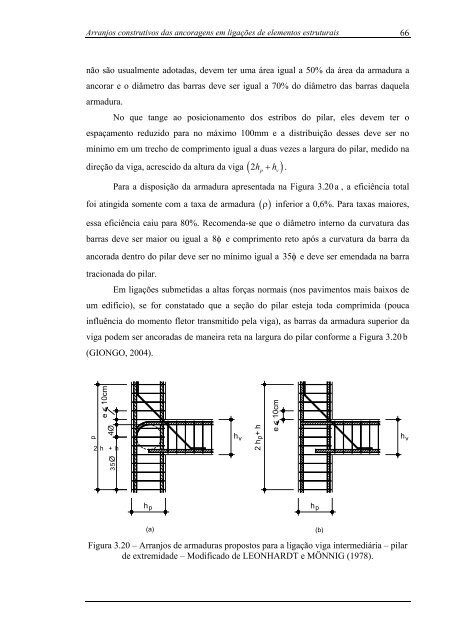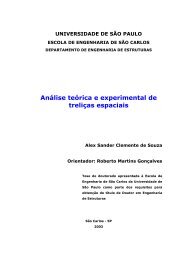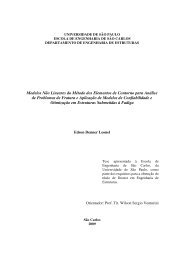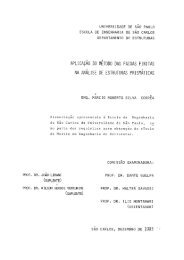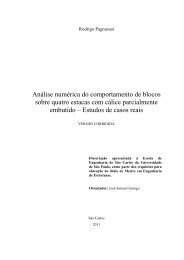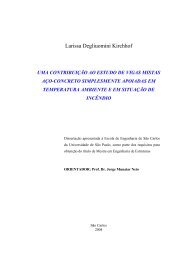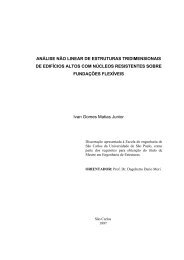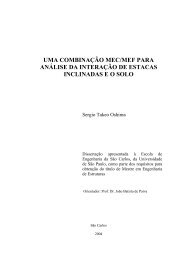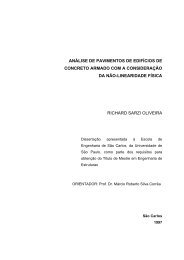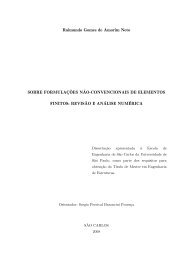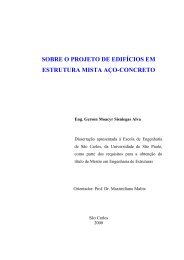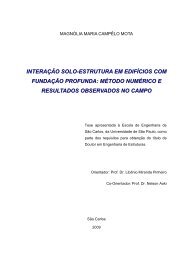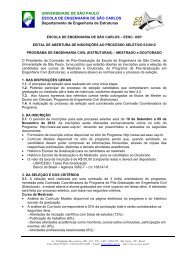análise numérica da ancoragem em ligações do tipo viga-pilar de ...
análise numérica da ancoragem em ligações do tipo viga-pilar de ...
análise numérica da ancoragem em ligações do tipo viga-pilar de ...
You also want an ePaper? Increase the reach of your titles
YUMPU automatically turns print PDFs into web optimized ePapers that Google loves.
Arranjos construtivos <strong>da</strong>s ancoragens <strong>em</strong> <strong>ligações</strong> <strong>de</strong> el<strong>em</strong>entos estruturais<br />
não são usualmente a<strong>do</strong>ta<strong>da</strong>s, <strong>de</strong>v<strong>em</strong> ter uma área igual a 50% <strong>da</strong> área <strong>da</strong> armadura a<br />
ancorar e o diâmetro <strong>da</strong>s barras <strong>de</strong>ve ser igual a 70% <strong>do</strong> diâmetro <strong>da</strong>s barras <strong>da</strong>quela<br />
armadura.<br />
No que tange ao posicionamento <strong>do</strong>s estribos <strong>do</strong> <strong>pilar</strong>, eles <strong>de</strong>v<strong>em</strong> ter o<br />
espaçamento reduzi<strong>do</strong> para no máximo 100mm e a distribuição <strong>de</strong>sses <strong>de</strong>ve ser no<br />
mínimo <strong>em</strong> um trecho <strong>de</strong> comprimento igual a duas vezes a largura <strong>do</strong> <strong>pilar</strong>, medi<strong>do</strong> na<br />
direção <strong>da</strong> <strong>viga</strong>, acresci<strong>do</strong> <strong>da</strong> altura <strong>da</strong> <strong>viga</strong> ( 2hp hv)<br />
+ .<br />
Para a disposição <strong>da</strong> armadura apresenta<strong>da</strong> na Figura 3.20 a , a eficiência total<br />
foi atingi<strong>da</strong> somente com a taxa <strong>de</strong> armadura ( ρ ) inferior a 0,6%. Para taxas maiores,<br />
essa eficiência caiu para 80%. Recomen<strong>da</strong>-se que o diâmetro interno <strong>da</strong> curvatura <strong>da</strong>s<br />
barras <strong>de</strong>ve ser maior ou igual a 8φ e comprimento reto após a curvatura <strong>da</strong> barra <strong>da</strong><br />
ancora<strong>da</strong> <strong>de</strong>ntro <strong>do</strong> <strong>pilar</strong> <strong>de</strong>ve ser no mínimo igual a 35φ e <strong>de</strong>ve ser <strong>em</strong>en<strong>da</strong><strong>da</strong> na barra<br />
traciona<strong>da</strong> <strong>do</strong> <strong>pilar</strong>.<br />
Em <strong>ligações</strong> submeti<strong>da</strong>s a altas forças normais (nos pavimentos mais baixos <strong>de</strong><br />
um edifício), se for constata<strong>do</strong> que a seção <strong>do</strong> <strong>pilar</strong> esteja to<strong>da</strong> comprimi<strong>da</strong> (pouca<br />
influência <strong>do</strong> momento fletor transmiti<strong>do</strong> pela <strong>viga</strong>), as barras <strong>da</strong> armadura superior <strong>da</strong><br />
<strong>viga</strong> pod<strong>em</strong> ser ancora<strong>da</strong>s <strong>de</strong> maneira reta na largura <strong>do</strong> <strong>pilar</strong> conforme a Figura 3.20 b<br />
(GIONGO, 2004).<br />
p<br />
e < 10cm<br />
4Ø<br />
2 h + h<br />
35Ø<br />
hp<br />
h v<br />
2 h p+<br />
h<br />
e < 10cm<br />
(a) (b)<br />
Figura 3.20 – Arranjos <strong>de</strong> armaduras propostos para a ligação <strong>viga</strong> intermediária – <strong>pilar</strong><br />
<strong>de</strong> extr<strong>em</strong>i<strong>da</strong><strong>de</strong> – Modifica<strong>do</strong> <strong>de</strong> LEONHARDT e MÖNNIG (1978).<br />
hp<br />
66<br />
h v


